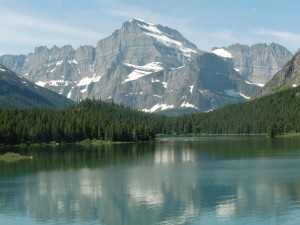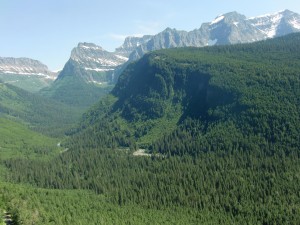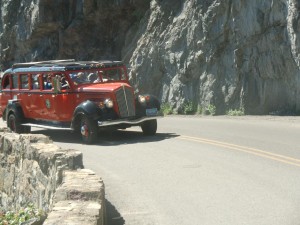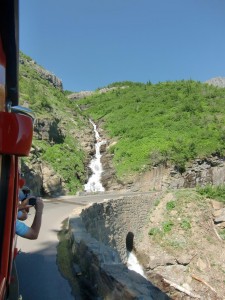EXPLORING THE ROCKIES – GLACIER PARK
EXPLORING THE ROCKIES
This is the 6th in a series of articles about traveling in the Canadian Rockies
GLACIER PARK
By Charles N. Stevens
Photos by Dolores Seidman
The dawn sky is clear as we see it over the A&W Root Beer stand, the rather ordinary view outside our hotel window. We never know what view we will get.
Today is Canada Day, similar to Independence Day in the United States without fireworks, celebrating the day they got their independence from Great Britain. They seem proud of the statement that, “We got our independence through negotiations, not revolution.” Many Canadians have dressed in red to honor the day.
Our bus rolls out of Lethbridge where we have stayed for the night, and heads into some of the greenest country I have ever seen—soft verdant canyons and rolling hills. Fields of wheat and hay are also deep green, contrasting sharply with the brilliant acres of yellow rape seed. A tractor cuts hay, the mown grass lying in even rows to dry in the sun. Seagulls sweep in behind the tractors, looking for insects. Previously cut hay lies in large round rolls scattered about the fields. Cows graze in pastures while a car traveling on a dirt road churns up clouds of dust. We begin to see the rugged snow-dappled peaks of the Rockies again in the distance.
We zip through Cardston again, its blocky, fortress-like Mormon temple blinding white in the morning sun. Soon at the border, the agents collect all our passports for careful checking. Once we are across the border, we are near the small town of Babb, Montana. The road leads through glacier-scoured valleys and follows a pleasant stream among stands of pines. A sign warns that we are back in bear country again. We stop to enter Glacier Park at the Many Glacier Entrance then proceed to the Many Glacier Hotel, a sprawling Alpine themed hotel, rising to four stories in some sections. The series of chalets was opened in 1915 by the Great Northern Railway and has a spectacular view of Swift Current Lake. A red canoe slips through the still lake water leaving a long V behind it. The surface is so quiet that the trees and the craggy peaks nearby are mirrored on its surface. Inside the hotel, we can look up four stories into the wooden rafters.
Reversing our track on the same road, we leave the park and join Highway 89 again. This takes us south along Saint Mary Lake to the town of Saint Mary where we reenter the park. At the village of Rising Sun we have lunch, Moose Drool Beer being on the menu. The camp grounds in the area are closed due to heightened bear activity. Once we were finished with lunch, we back tracked to Highway 89. We have to stop for loose horses and colts on the road and look warily at cows nibbling close to the road. As we travel, all of us agree that Montana is truly the state of the “Big Sky.” We essentially drive many miles around the edges of Glacier Park until we arrive at its southern entrance at Apgar.
Back in the park again, we roll past Lake McDonald to nearly its northern tip, the lake quiet and peaceful, with tourists rowing red canoes on the sparkling water. We stop at the Lake McDonald Lodge the afternoon having become quite warm. It is here that we begin our special ride up the Going-to-the-Sun Road in bright red, open-topped touring cars, each of them holding seventeen people. The driver of our car is a very small but energetic woman with long bleached blonde hair. As we begin our drive we follow the edge of Lake McDonald then the tumbling water of McDonald Creek. It is good to have an open-topped car so we can see all the sights, but the sun bears down on us with blazing heat. My back perspires against the seat. We continue to rise in altitude, passing many trails that lead into tall cedars. The road then leads up along the sheer wall of granite, the road carved out of it at great expense and danger. It is truly an engineering marvel. Melt water from the snowfields above cascades down part of the granite wall. We are so close to the falls that we can hear their roar and splashing, sometimes even feeling their cool spray on our faces. Absolutely fascinating! We drive into a “weeping” tunnel and pass water creeping down the rocks and on to the road. In wet places moss and plants grow in a profusion of green. Far across the way we can see the delicate veil of Bird Woman Falls and peer down in the valley from which we had come. We are up high enough now that we encounter marbled snow patches streaked with dirt.
Finally we reach the summit at Logan Pass, our altitude 6,646 feet, 3,000 feet higher than when we started. Snow patches are everywhere, and the air is cool, so different from the heat at our starting point. There are many tourists here as well as facilities and cool drinking water. Three white mountain goats, two adults and a baby tagging along with them,climb on the rocks nearby. The nice part about being here is that we will repeat the same wonderful experience on the return trip.
Once back down, we have dinner at the West Glacier Café then we travel forever, it seems, to our hotel at Flathead Lake, near Polson, Montana. We would have had some beautiful views from this hotel, but it is dark now, and we see nothing. Worn out by the long ride, we want only to find our room and rest. The views would have to wait for the morning.
Tomorrow we fly home, carrying with us some of the most beautiful sights we have ever seen.

We continue to enjoy breathtaking scenes like this in Glacier Park.

U-shaped valleys like this one show the work of glaciers in the past.

We climb the "Road to the Sun" in special red tourist cars like this one.

One of the views from our tourist car on this hair raising road.
MONTEREY PARK AUTHOR PUBLISHES 4th BOOK – Seeking More of the Sky: Growing Up in the 1930’s:
Charles “Norm” Stevens, a 43 year resident of Monterey Park has recently published his 4th book: Seeking More of the Sky: Growing Up in the 1930’s. This is the story of a young boy growing up in Inglewood, California in the l930’s. This was a time during the depression when unemployment was affecting many and the banks were closed, while the clouds of war were gathering in Europe. But he was lucky enough to be raised in a loving family, the power of that love reflected throughout his stories.
Stevens is the author of three previous books about his experiences during WWII:
An Innocent at Polebrook: A Memoir of an 8th Air Force Bombardier (Story of his 34 bombing missions from his base at Polebrook, England over Germany and France)
The Innocent Cadet: Becoming A World War II Bombardier (A prequel to the first, telling of his training in the U.S. before going overseas into combat.)
Back from Combat: A WWII Bombardier Faces His Military Future from Combat: (This book details the time from when he returned from combat in England until the end of the war.)
He is known to the readers of The Citizen’s Voice as the author of Travel Log Articles including “Cruising the Rhine and Mosel”,” Best of the West”, “In Search of Snow” , “From Paris to Normandy on the Seine”, and “Exploring New York”. He is retired, having taught for 32 years, primarily in the Montebello Unified School District.
Those interested in purchasing an autographed copy of any of his books, may contact the author at 323-721-8230 or Normstevens24@gmail.com.



